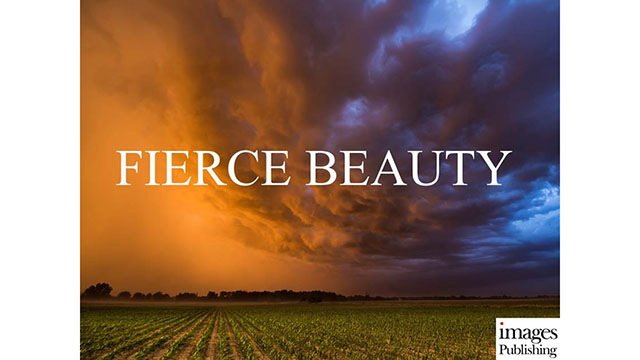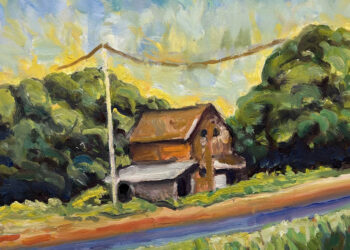Hamptons resident and photographer Eric Meola’s latest book, Fierce Beauty: Storms of the Great Plains, is a striking compilation of atmospheric photographs, including tornadoes, lightning, dust storms and storm phenomena, taken across the heartlands of America.
We had the pleasure of catching up with Meola about the captivating images, storm chasing, working with Bruce Springsteen, and more.
Could you discuss your first initiation into storm chasing?
EM: In 1977 I made a road trip out to Nevada with Bruce Springsteen, to make photographs for his album Darkness on the Edge of Town, and we encountered a spectacular desert storm midway through our drive from Salt Lake City, Utah, to Reno, Nevada. Elvis Presley had died the week before, and Springsteen wrote a song about that storm and about America called The Promised Land. The storm had a profound effect on both of us, as it was so cinematic in scale and scope—it was almost biblical. Years later, in the spring of 2011, I happened to watch the aftermath of a tornado on TV that had passed through Joplin, Missouri; and I made a decision right then to travel out to the Great Plains to photograph storms. My first trip was in 2013, and I had no idea what I was getting into, but it turned out to be a spectacular season for tornadoes, and lightning. I spent a month with a company called Tempest Tours, and we saw three tornadoes, lots of lightning, spectacular skies, and drove as far north as Saskatchewan, averaging 500 miles of driving each day.
 |
|
Photographer Eric Meola. (Courtesy Photo) |
What was it like working with Bruce Springsteen on his album, The Promise?
EM: The cover for Bruce’s album The Promise came from the photographs we made for the album Darkness on the Edge of Town. Back in 1977 Bruce was still relatively unknown, so we could travel without him being recognized, and our road trip in the desert was just us driving in a car in the desert with no particular place to go. He’s very down-to-earth, yet very intense. He’s a sponge, and always observing what’s going on around him. He’s always been open to suggestions and puts total trust in you, and he’s very easy to get along with, so he makes it easy for you to make great images. And he’s always been very complimentary. I had no idea he was working on his latest album Western Stars when I asked him for a blurb to put on my storm book Fierce Beauty, but as it turns out we’ve always both loved the desert, and the landscapes and skies of the West. So I was grateful when he wrote such a thoughtful paragraph about what I was trying to evoke—the grandeur of America, and the epic nature of the landscapes.
How do you select the locations you shoot?
EM: Each day chasing storms starts with a weather briefing by a meteorologist. He’s looked at all the possibilities within a few hundred miles of wherever we are, and he’s also looked at the weather for the next day or two, because you don’t want to go too far north or south, and miss the potential for a great storm in a few days when the immediate prospects don’t look promising; so the decisions are based on science, but there’s a bit of chess involved as you try to think ahead to the best moves. In my first season, we drove from Denver way up into Canada in just a day-and-a-half because there weren’t any storms in Colorado, but the prospects looked much better up north.
 |
|
“My first trip was in 2013, and I had no idea what I was getting into, but it turned out to be a spectacular season for tornadoes, and lightning,” Meola told us about his initiation into storm chasing. (Photo: Eric Meola) |
As weather can be rather unpredictable, how do you prepare for a shoot?
EM: I’ve learned to always be ready, as one storm can greatly affect another one next to it, and several storms often form in a long line covering hundreds of miles and crossing State lines. My camera equipment is always ready, and we all have radar apps on our cell phones and laptops; and we also have a monitor with a live GPS map update and streaming radar overlay. So we always know when we’re getting close, and over time I’ve picked up some terminology, along with strategy. However, you’re always learning, and each storm is, of course, unique.
What was the most challenging image to capture?
EM: The last photograph in the book, a tornado at night which is called a “nocturnal” tornado, was the most challenging image I’ve made, and it also involved a lot of luck. We had been chasing several tornadoes in southeastern Montana, and one of them continued into southwestern South Dakota. We pulled off the road to photograph some lightning in the pitch darkness, and as we watched the sky light up we could see the silhouette of a tornado along the horizon. I set up a tripod and made several time exposures, and in one frame the lightning struck just behind the tornado. It was a setup that I’ll probably never see again, and I didn’t realize I had caught this image until we got to a hotel very late that evening.
 |
|
An image from Fierce Beauty: Storms of the Great Plains. (Photo: Eric Meola) |
Is there anywhere you haven’t photographed yet that’s on your bucket list? What are you working on next?
EM: I don’t think in terms of “bucket lists”. The projects I give myself now tend to be long-range and require going back to a place several times over several years. I’d love to do something on birds, as they are literally the canary in the coal mine of climate change. Just how and if I will take that idea and create a series of images around it remains the puzzle I have yet to figure out. I’ve been to Antarctica several times, and I’d love to go back again.
As a Hamptons resident, do you have any spots you’re drawn to capture?
EM: I love the ocean out here, but really the Hamptons are, for me, a place where I try to relax and just read books and be in the moment. I don’t always need to be photographing, and sometimes you just have to enjoy beauty for what it is and not make a photograph of it. I live here because of the farms and the air, and the people and the history. It’s where I can recharge and just enjoy life, which turns out to be something you either work at or for some people comes naturally.
Is there anything else you would like to add?
EM: I’ve always tried to follow my gut—my instincts—about what to photograph. We’re all dreamers, but some of us actively pursue those dreams and make them come true. The quote by Minor White at the beginning of my new book says it all: “A photographer is someone who has his head in the clouds and his feet on the ground.” So it’s not just about making photographs for me; it’s about pursuing your dreams wherever they go.
Fierce Beauty: Storms of the Great Plains is available at BookHampton (41 Main Street, East Hampton) and Sylvester & Co. Modern General® (103 Main Street, Sag Harbor).
For more information, visit www.ericmeola.photography.












